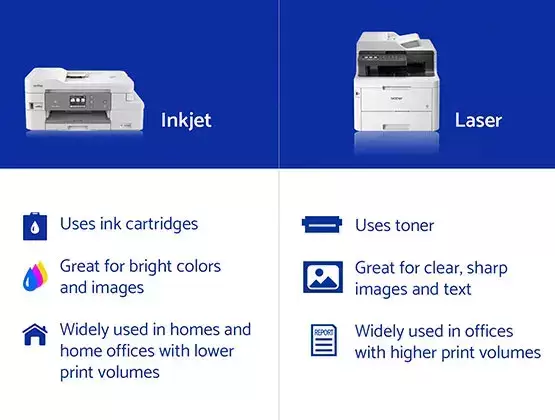Laser Printer Vs. Inkjet : Questions To Ask Before BuyingChoosing between a laser printer and an inkjet printer involves considering various factors based on your specific needs and preferences. Here are key questions to ask before buying a printer:
1. What Is the Primary Purpose of the Printer? - Consider whether you need a printer primarily for text documents, graphics, or a combination of both. Laser printers are often preferred for text-heavy printing, while inkjet printers can offer high-quality photo printing. 2. What Is Your Expected Printing Volume? - Evaluate your printing volume in terms of pages per month. Laser printers are generally more suitable for high-volume printing, while inkjet printers are often preferred for lower to moderate printing volumes. 3. Is Speed a Critical Factor? - Assess your need for printing speed. Laser printers are known for their fast printing speeds, making them ideal for high-demand environments such as offices. Inkjet printers vary in speed, with some models offering competitive speeds for certain applications. 4. What Is Your Budget? - Determine your budget for the printer purchase. Generally, entry-level monochrome laser printers are more budget-friendly, while high-end color laser printers and certain photo-quality inkjet printers may have a higher upfront cost. 5. Do You Need Color Printing? - Decide whether color printing is essential for your needs. Inkjet printers are well-known for producing vibrant color prints and are often preferred for photo printing. Laser printers are commonly used for monochrome or color document printing. 6. What Is the Cost Per Page? - Evaluate the cost per page, including both the printer and consumables (toner or ink cartridges). Laser printers tend to have a lower cost per page for monochrome printing, while inkjet printers may have a higher cost for color printing. 7. What Is the Quality of Text and Graphics Output You Require? - Consider the quality of text and graphics output needed for your documents. Laser printers generally excel in producing sharp text, while inkjet printers can offer high-quality graphics and color reproduction. 8. How Important Is Print Resolution? - Assess the importance of print resolution, especially if you require high-quality photo prints. Inkjet printers often have higher resolution capabilities, providing finer details in photo printing. 9. What Paper Types and Sizes Will You Be Using? - Determine the types and sizes of paper you plan to use. Inkjet printers are versatile in handling different paper types, including glossy photo paper, while laser printers may have limitations in certain specialty papers. 10. Do You Need Multifunctionality (Print, Copy, Scan, Fax)? - Consider whether you require additional functionalities such as scanning, copying, and faxing. Both laser and inkjet printers are available as multifunction devices, but features and performance can vary. 11. How Important Is Printer Size and Form Factor? - Assess the physical size and form factor of the printer. Laser printers are generally more compact and suitable for small office spaces, while inkjet printers vary in size and design. 12. What Connectivity Options Are Important? - Evaluate connectivity options such as USB, Ethernet, Wi-Fi, and mobile printing capabilities. Ensure that the printer's connectivity aligns with your office setup and device preferences. 13. Is Energy Efficiency a Consideration? - Consider the energy efficiency of the printer. Laser printers often have lower energy consumption per page, making them more efficient for high-volume printing. Inkjet printers can vary in energy efficiency. 14. What Is the Noise Level Tolerance in Your Workspace? - Assess the noise level produced by the printer. Laser printers generally operate more quietly than older inkjet models, but advancements in inkjet technology have led to quieter printing. 15. Is Ease of Maintenance Important? - Consider the ease of maintenance, including replacing consumables and performing routine tasks. Laser printers typically require less frequent cartridge changes, while inkjet printers may have more accessible consumables. 16. What Is the Longevity of Prints? - Consider the longevity of prints, especially if you require documents or photos to be archival quality. Both laser and inkjet technologies offer options for longer-lasting prints. 17. Are There Brand or Model Preferences? - Do you have preferences based on brand reputation or specific printer models? Research reviews and user experiences to identify reliable brands and models that meet your requirements. 18. Have You Considered User Reviews and Ratings? - Read user reviews and ratings for specific printer models. Real-world experiences from users can provide valuable insights into the performance, reliability, and user-friendliness of a printer. 19. What Are the Maintenance and Support Options? - Investigate the availability of maintenance and support options. Check warranty terms, customer support responsiveness, and the availability of extended service plans. 20. Have You Considered Future Compatibility and Upgrades? - Consider the potential for future compatibility and upgrades. Ensure that the chosen printer can adapt to evolving technology and remain compatible with software and operating systems. By answering these questions, you can narrow down your options and make an informed decision based on your specific printing needs, budget constraints, and desired features. Whether you choose a laser printer or an inkjet printer, selecting the right model for your requirements is key to achieving optimal printing results.
0 Comments
Leave a Reply. |
AuthorFSM Solution Archives
December 2023
Categories |
- Home
- Online Store
-
Products
- Office Printer
- Interactive White Board
- FujiFilm Photocopy Machine
- Recondition Photocopier
- Production Printer
- A1 A0 Plan Printer
- Large Format Printer
- Large Format Scanner
- Document Scanner
- Fax Machine
- Projector
- Roll Sticker Label Cutter And Waste Removal
- Sheet & Roll Flatbed Cutter
- Production CNC Cutter
- Form Board Printer
- Art Card Printer
- Roll Art Card Printer
- Roll Sticker Printer
- T-Shirt Printer
- UV DTF Sticker Printer
- Software
- Services
- Support
- About Us
- Home
- Online Store
-
Products
- Office Printer
- Interactive White Board
- FujiFilm Photocopy Machine
- Recondition Photocopier
- Production Printer
- A1 A0 Plan Printer
- Large Format Printer
- Large Format Scanner
- Document Scanner
- Fax Machine
- Projector
- Roll Sticker Label Cutter And Waste Removal
- Sheet & Roll Flatbed Cutter
- Production CNC Cutter
- Form Board Printer
- Art Card Printer
- Roll Art Card Printer
- Roll Sticker Printer
- T-Shirt Printer
- UV DTF Sticker Printer
- Software
- Services
- Support
- About Us
Online Store
Product |
Services |
Authorized Sales & Services
|
Contact Us |
Copyright © 2024 FSM Solution Sdn Bhd. All Rights Reserved.


 RSS Feed
RSS Feed














